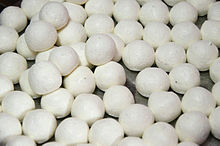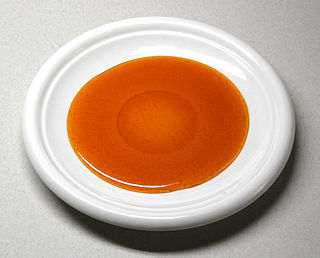
Caramel is an orange-brown confectionery product made by heating a range of sugars. It can be used as a flavoring in puddings and desserts, as a filling in bonbons or candy bars, or as a topping for ice cream and custard.

Halva is a type of confectionery originating from Persia and widely spread throughout the Middle East as well as South Asia. The name is used for a broad variety of recipes, generally a thick paste made from flour, butter, liquid oil, saffron, rosewater, milk, cocoa powder, and sweetened with sugar.

Curd is obtained by coagulating milk in a sequential process called curdling. It can be a final dairy product or the first stage in cheesemaking. The coagulation can be caused by adding rennet, a culture, or any edible acidic substance such as lemon juice or vinegar, and then allowing it to coagulate. The increased acidity causes the milk proteins (casein) to tangle into solid masses, or curds. Milk that has been left to sour will also naturally produce curds, and sour milk cheeses are produced this way.

Fudge is a type of confection that is made by mixing sugar, butter and milk. It has its origins in the 19th century United States, and was popular in the women's colleges of the time. Fudge can come in a variety of flavorings depending on the region or country it was made; popular flavors include fruit, nut, chocolate and caramel. Fudge is often bought as a gift from a gift shop in tourist areas and attractions.

Gulab jamun is a sweet confectionery or dessert, originating in Persia. It is popular in India, Pakistan as well as Myanmar. It is also common in nations with substantial populations of people with South Asian heritage, such as Mauritius, Fiji, Gulf states, the Malay Peninsula, Great Britain, South Africa, and the Caribbean countries of Trinidad and Tobago, Guyana, Suriname, and Jamaica.

Rasgulla is a syrupy dessert popular in the eastern part of South Asia. It is made from ball-shaped dumplings of chhena dough, cooked in light sugar syrup. This is done until the syrup permeates the dumplings.

Barfi or burfi is a milk-based sweet from the Indian subcontinent with a fudge-like consistency. Its name comes from the Persian and Urdu word (barf) for snow. Barfi is consumed throughout India and Pakistan and is especially popular in North India. It is often served at celebrations and religious festivals such as Diwali and Holi.
Mithai (sweets) are the confectionery and desserts of the Indian subcontinent. Thousands of dedicated shops in India, Bangladesh, Nepal, Pakistan and Sri Lanka sell nothing but sweets.

Khoa, khoya, khowa or mawa is a dairy food widely used in the cuisines of the Indian subcontinent, encompassing India, Nepal, Bangladesh and Pakistan. It is made of either dried whole milk or milk thickened by heating in an open iron pan. It is lower in moisture than typical fresh cheeses such as ricotta. It is made up of whole milk instead of whey.

Ras malai, also known as rosomalai, or roshmalai, is a dessert from the Indian subcontinent. The dessert is called roshmalai/rosmalai in Bengali, ras malai in Hindi, and rasa malei in Odia. It is popular in India, Bangladesh and Pakistan.

Peda or Pera is an Indian sweet that originated in the city of Mathura, Uttar Pradesh, India. Traditionally prepared as thick, semi-soft round balls, its main ingredients are khoa, sugar and traditional flavourings including cardamom seeds. It is brown in colour. Variant spellings and names for the dessert include pedha, penda and pera.
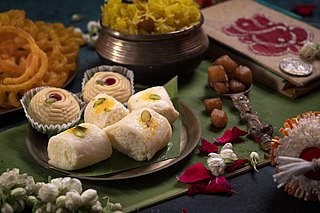
Sandesh is a dessert, originating from the Bengal region in the eastern part of the Indian subcontinent, created with milk and sugar. Some recipes of sandesh call for the use of chhena or paneer instead of milk itself. Some people in the region of Dhaka make a form of sandesh called pranahara which is softer and made with mawa and yogurt. The Gupo/Gufo style of sandesh from Guptipara is considered by some to be the "first branded sweet of Bengal".

Chhena poda is a cheese dessert from the Indian state of Odisha. Chhena poda literally means Baked Cheese in Odia. It is made of well-kneaded homemade fresh cheese chhena, sugar, semolina, and is baked for several hours until it browns. Chhena poda is known as one of the Indian dessert whose flavor is predominantly derived from the caramelization of sugar.
Bhojpuri cuisine is a style of food preparation common among the Bhojpuri people of Bihar and eastern Uttar Pradesh in India, and also the Terai region of Nepal. Bhojpuri foods are mostly mild and tend to be less hot in terms of spices used. The cuisine consists of both vegetable and meat dishes.
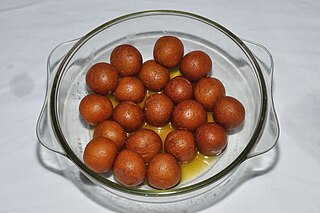
Pantua is a local confection from the Indian subcontinent, notable in West Bengal, Eastern India and Bangladesh. It is a traditional Bengali sweet made of deep-fried balls of semolina, chhena, milk, ghee and sugar syrup. Pantuas range in colour from pale brown to nearly black depending on how long they are fried. Rose water, cardamom or other flavourings are sometimes added to the sweet.
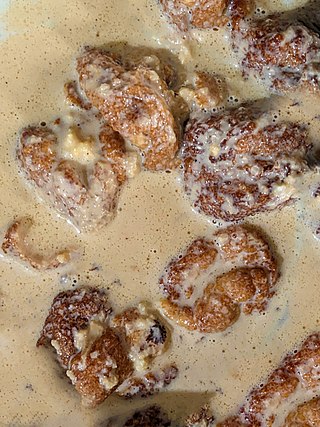
Rasabali is a sweet dish from Odisha, India. Rasabali is offered to Baladevjew, and originated in the Baladevjew Temple of Kendrapara. It is one of the Chapana bhoga of Jagannath temple. Kendrapara's Rasabali got GI tag on 3 October 2023.

Gujhia, also known as Gughara, Pedakiya, Karanji, Kajjikayalu, Somas, and Karjikayi, is a sweet, deep-fried pastry that is a popular dessert in the Indian subcontinent. This delicacy is made using either suji (semolina) or maida, which is stuffed with a mixture of sweetened khoa and dried fruits. The dumpling is then fried in ghee to give it a crispy texture.

Chhena or chhana are a style of cheese, originating from the Indian subcontinent, made from water buffalo or regular cow milk by adding food acids such as lemon juice and calcium lactate instead of rennet and straining the whey through filtration.
Mirzapur is a village in Ishwarganj Upazila of Mymensingh District in the Division of Mymensingh, Bangladesh.
